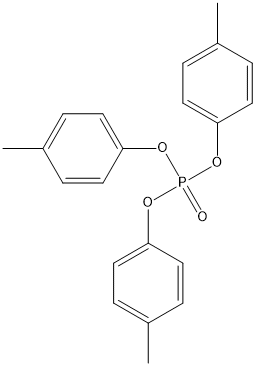Tricresyl-phosphate
General
Type : Organophosphate,Organophosphorus flame retardant plasticizer,OPIDN-OP
Chemical_Nomenclature : tris(4-methylphenyl) phosphate
Canonical SMILES : CC1=CC=C(C=C1)OP(=O)(OC2=CC=C(C=C2)C)OC3=CC=C(C=C3)C
InChI : InChI=1S\/C21H21O4P\/c1-16-4-10-19(11-5-16)23-26(22,24-20-12-6-17(2)7-13-20)25-21-14-8-18(3)9-15-21\/h4-15H,1-3H3
InChIKey : BOSMZFBHAYFUBJ-UHFFFAOYSA-N
Other name(s) : Tri-p-tolyl phosphate,Tri-p-cresyl phosphate,Tricresyl-phosphate,Tris(4-methylphenyl) phosphate,SCHEMBL21582,CHEMBL1596847
MW :
Formula : C21H21O4P
CAS_number : 78-32-0
PubChem : 6529
UniChem : BOSMZFBHAYFUBJ-UHFFFAOYSA-N
IUPHAR :
Wikipedia :

Target
References (10)
| Title : Cholinesterase Inhibition and Exposure to Organophosphate Esters in Aircraft Maintenance Workers - Hardos_2020_Aerosp.Med.Hum.Perform_91_710 |
| Author(s) : Hardos JE , Rubenstein M , Pfahler S , Sleight T |
| Ref : Aerospace Medicine Hum Perform , 91 :710 , 2020 |
| Abstract : Hardos_2020_Aerosp.Med.Hum.Perform_91_710 |
| ESTHER : Hardos_2020_Aerosp.Med.Hum.Perform_91_710 |
| PubMedSearch : Hardos_2020_Aerosp.Med.Hum.Perform_91_710 |
| PubMedID: 32867901 |
| Title : Intestinal damage, neurotoxicity and biochemical responses caused by tris (2-chloroethyl) phosphate and tricresyl phosphate on earthworm - Yang_2018_Ecotoxicol.Environ.Saf_158_78 |
| Author(s) : Yang Y , Xiao Y , Chang Y , Cui Y , Klobucar G , Li M |
| Ref : Ecotoxicology & Environmental Safety , 158 :78 , 2018 |
| Abstract : Yang_2018_Ecotoxicol.Environ.Saf_158_78 |
| ESTHER : Yang_2018_Ecotoxicol.Environ.Saf_158_78 |
| PubMedSearch : Yang_2018_Ecotoxicol.Environ.Saf_158_78 |
| PubMedID: 29660616 |
| Title : Reaction of cresyl saligenin phosphate, the organophosphorus agent implicated in aerotoxic syndrome, with human cholinesterases: mechanistic studies employing kinetics, mass spectrometry, and X-ray structure analysis - Carletti_2011_Chem.Res.Toxicol_24_797 |
| Author(s) : Carletti E , Schopfer LM , Colletier JP , Froment MT , Nachon F , Weik M , Lockridge O , Masson P |
| Ref : Chemical Research in Toxicology , 24 :797 , 2011 |
| Abstract : Carletti_2011_Chem.Res.Toxicol_24_797 |
| ESTHER : Carletti_2011_Chem.Res.Toxicol_24_797 |
| PubMedSearch : Carletti_2011_Chem.Res.Toxicol_24_797 |
| PubMedID: 21438623 |
| Gene_locus related to this paper: human-BCHE |
| Title : Exposure to triaryl phosphates: metabolism and biomarkers of exposure - Furlong_2011_J.Biol.Phys.Chem_11_ |
| Author(s) : Furlong CE |
| Ref : J Biol Phys Chem , 11 : , 2011 |
| Abstract : Furlong_2011_J.Biol.Phys.Chem_11_ |
| ESTHER : Furlong_2011_J.Biol.Phys.Chem_11_ |
| PubMedSearch : Furlong_2011_J.Biol.Phys.Chem_11_ |
| PubMedID: 24285929 |
| Title : Induction of plasma acetylcholinesterase activity in mice challenged with organophosphorus poisons - Duysen_2011_Toxicol.Appl.Pharmacol_255_214 |
| Author(s) : Duysen EG , Lockridge O |
| Ref : Toxicol Appl Pharmacol , 255 :214 , 2011 |
| Abstract : Duysen_2011_Toxicol.Appl.Pharmacol_255_214 |
| ESTHER : Duysen_2011_Toxicol.Appl.Pharmacol_255_214 |
| PubMedSearch : Duysen_2011_Toxicol.Appl.Pharmacol_255_214 |
| PubMedID: 21767560 |
| Title : Development of diagnostics in the search for an explanation of aerotoxic syndrome - Schopfer_2010_Anal.Biochem_404_64 |
| Author(s) : Schopfer LM , Furlong CE , Lockridge O |
| Ref : Analytical Biochemistry , 404 :64 , 2010 |
| Abstract : Schopfer_2010_Anal.Biochem_404_64 |
| ESTHER : Schopfer_2010_Anal.Biochem_404_64 |
| PubMedSearch : Schopfer_2010_Anal.Biochem_404_64 |
| PubMedID: 20447373 |
| Title : Identification and characterization of biomarkers of organophosphorus exposures in humans - Kim_2010_Adv.Exp.Med.Biol_660_61 |
| Author(s) : Kim JH , Stevens RC , Maccoss MJ , Goodlett DR , Scherl A , Richter RJ , Suzuki SM , Furlong CE |
| Ref : Advances in Experimental Medicine & Biology , 660 :61 , 2010 |
| Abstract : Kim_2010_Adv.Exp.Med.Biol_660_61 |
| ESTHER : Kim_2010_Adv.Exp.Med.Biol_660_61 |
| PubMedSearch : Kim_2010_Adv.Exp.Med.Biol_660_61 |
| PubMedID: 20221871 |
| Title : Effects of tricresylphosphate on esterase activity of rat serum and tissues - Manno_1979_Br.J.Ind.Med_36_153 |
| Author(s) : Manno M , Rigoni F , Bartolucci GB , Bianchi M , Mazzotta M |
| Ref : British Journal of Industrial Medicine , 36 :153 , 1979 |
| Abstract : Manno_1979_Br.J.Ind.Med_36_153 |
| ESTHER : Manno_1979_Br.J.Ind.Med_36_153 |
| PubMedSearch : Manno_1979_Br.J.Ind.Med_36_153 |
| PubMedID: 465377 |
| Title : Polyneuritis incidence in shoe factory workers: cases report and etiological considerations - Cavalleri_1978_Arch.Environ.Health_33_192 |
| Author(s) : Cavalleri A , Cosi V |
| Ref : Archives of Environmental Health , 33 :192 , 1978 |
| Abstract : Cavalleri_1978_Arch.Environ.Health_33_192 |
| ESTHER : Cavalleri_1978_Arch.Environ.Health_33_192 |
| PubMedSearch : Cavalleri_1978_Arch.Environ.Health_33_192 |
| PubMedID: 686846 |
| Title : CHOLINESTERASE ACTIVITY IN MOTOR END PLATES OF SKELETAL MUSCLES IN TRICRESYL PHOSPHATE POISONING--PRELIMINARY OBSERVATIONS - |
| Author(s) : Mitra NK , Sengupta PC |
| Ref : Bull Calcutta Sch Trop Med , 12 :47 , 1964 |
| PubMedID: 14240681 |